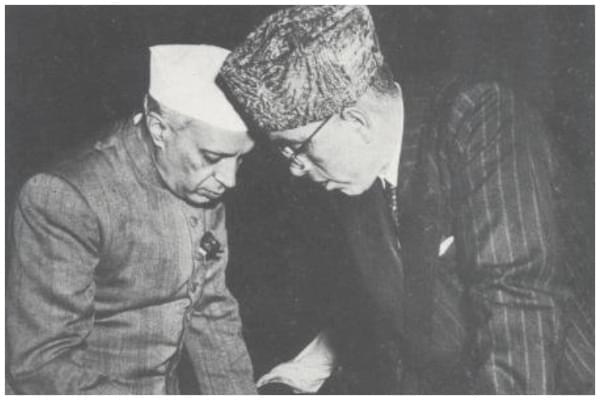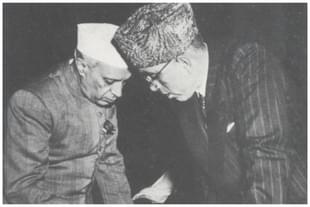Politics
Reformist Leader, Communalist ‘Monarch’: The Legacy Of Sheikh Abdullah
Arshia Malik
Sep 17, 2023, 04:06 PM | Updated 05:25 PM IST
Save & read from anywhere!
Bookmark stories for easy access on any device or the Swarajya app.


"He had a vision in 1951 when he was speaking about economic interests which the world is talking about today," said Chief Justice of India, DY Chandrachud, while hearing a bunch of petitions related to Article 370.
The person being referred to in the third-person pronoun here was Sheikh Abdullah, former prime minister and chief minister of Jammu and Kashmir and the progenitor of one of the two dynasties currently active in the Valley—the Abdullahs.
As the modern history of Jammu and Kashmir is part of national headlines, thanks to the hearing in the apex court, here is an opportunity for us to discuss: in the final analysis, what really is the legacy of Sheikh Abdullah?
Sheikh Muhammad Abdullah is both celebrated as the "Lion of Kashmir'' and a figure of contention in the region's history. How people view him is largely dependent on who you ask: Kashmiri Muslims, Pandits, or other minority communities in the Union Territory of Jammu and Kashmir.
In various polls, Sheikh Muhammad Abdullah is ranked as one of the most influential Indians of the 20th century, particularly concerning the events of the 1940s. His supporters credit the Sheikh for doing the groundwork for establishing a political system in Jammu and Kashmir and for championing social and economic reforms.
Yet, since the 1990s, his mausoleum has to be manned with security personnel round the clock due to terror threats by various insurgent groups.
Sheikh Abdullah was born in Soura, a village in the Kashmir valley on 5 December 1905. His journey in political activism began during the 1930s, when he joined the Kashmiri Muslim Conference, which later evolved into the National Conference.
He became a prominent voice for advocating for the rights of the people of Jammu and Kashmir against the rule of the Maharaja of Jammu and Kashmir. He demanded social, political, and land reforms to address the issue of landlessness, and increased representation for the local population in governing bodies.
After India gained independence from British rule in 1947, Sheikh Abdullah played a significant role in negotiating the terms of Jammu and Kashmir's accession to India. Subsequently, he was appointed the Prime Minister of Jammu and Kashmir.
Many point to his close association with the Nehru family as the basis for his stance on the formation of Pakistan. This viewpoint was also emphasized by the current Chief Justice of India, Justice Chandrachud. He intervened during a hearing on petitions against the abrogation of Article 370 when senior lawyer Kapil Sibal omitted certain parts of Sheikh Mohammad Abdullah's speech in the constituent assembly.
Justice Chandrachud referred to Sheikh Abdullah's speech and praised him as a visionary. The Sheikh had argued that Pakistan's claim of being a Muslim state was a camouflage to maintain a feudal power structure, and that India's land reforms made it a better choice for protecting their interests. The CJI highlighted Sheikh Abdullah's foresight in recognizing the importance of economic interests in 1951, which is still relevant today.
Sheikh Abdullah held various political positions in Jammu and Kashmir, serving as Prime Minister and later as Chief Minister.
His tenure, however, was marked by political instability, ideological shifts, and changing alliances. His alliance with the Indian National Congress, followed by a period of disagreement and incarceration, created complex dynamics within the state's political landscape, for which he was briefly removed from office in 1953 and incarcerated for years but was later reinstated as Chief Minister in 1975.
These ideological shifts, changing loyalties, and political instability was continued by his son Dr Farooq Abdullah, well into the 80s and 90s which saw an armed Islamist insurgency in the erstwhile state. His tenure also witnessed the ethnic cleansing of Kashmiri Pandits and the deaths of scores of secular, pro-India Kashmiris.
The Kashmiri Muslim community acknowledges as one that Sheikh Abdullah's reforms and resistance to the Dogra rule did more for the upliftment of backward and impoverished Muslims in the Valley than the efforts of any other leader.
According to Professor Noor Ahmad Baba, HoD Department of Sociology, and author of several books, now retired from Kashmir University and an expert on the local socio-economic situation, the foundation of Kashmir’s development was laid long back. He emphasises that the foundation of Kashmir's development was established with the introduction of land reforms (land to the tiller), which ended the feudal lord system and distributed land among peasants, ensuring access to resources and promoting parity.
The National Conference, now the party of one dynasty, prioritized social justice, women empowerment, and human development in 1944, setting the stage for progress in Kashmir post 1947.
According to an opinion piece written by Haseeb Drabu, former J&K finance minister, this is visible in the data showing how J&K beats the all-India average on several key parameters such as child sex ratio and women's education, thus defying many stereotypes.
The rural income disparity and indebtedness in J&K are low compared to the national average. The economic empowerment of the poorest in J&K is evident from the low percentage of landless laborers and the significant contribution of own cultivation to household earnings.
Noor Ahmed Baba reiterates the data to emphasise that early investments in education and healthcare helped J&K in achieving development goals.
The successive governments in Kashmir invested heavily in education and healthcare, leading to early development and long-term impact on developmental outcomes, which is the legacy of Sheikh Mohd Abdullah. The handicrafts industry in rural areas of Kashmir has contributed to low disparity between rural and urban areas, providing employment opportunities for women and improving the overall economic transition in the region.
On the other hand, observers also say that a primary reason for Kashmir scoring high on many indicators is the support from the Centre that it has received over the years.
As this report from 2016 states, over a 16-year period from 2000-2016, J&K got 10 per cent of all Central funds given to states while having only one per cent of the population of the country. Central grants accounted for 54 per cent of the state’s total revenue and 44 per cent of its expenditure in FY16. It is unlikely that in the years and decades prior to 2000, the situation was drastically different.
The perspective of the Kashmiri Pandit community too, those who stayed behind despite the ethnic cleansing, those who settled in India and the Pandit diaspora, varies from that of the majority Kashmiris.
Many elderly Pandits also state that the same land reforms (land to the tiller act) rendered many Pandits poor because adequate compensation was not given.
The new landlords who were Muslims converted the lands into orchards and amassed capital, but the Pandits were hampered by bureaucratic red tape. This also resulted in an economic exodus, long before the forced and bloody migration of the 1990s, when young KP men started applying for jobs in mainland India because the same were inaccessible to them in the Valley due to the Abdullah dynasty nepotism.
The communal politics of the National Conference members became apparent only after the Sheikh was arrested and his seditious activities came to light.
Class struggle which the early movements of the 1930s had tried to solve were still a large part of the Kashmiri socio-economic milieu three decades after India's Independence. The infamous Maharajgunj riots in which Pandit shops were looted and burnt are a big blot on the history of National Conference whose secularism and national integration the Sheikh's grandson, Omar Abdullah likes to trumpet till this day.
There were cases pending in J&K courts of Pandits challenging the government establishment on their delayed promotions and other incentives due to NC's communalism. After 1990, all that record and documentation went up in smoke figuratively.
So, this trope that all Pandits were rich and dominated the professional and government sectors has come into academia, and mainstream media via the usual Left-Liberal intellectuals. Scores of Kashmiri Pandit families talk about impoverishment and deprivation in the 50s and 60s due to the National Conference's communal politics and their nepotism as well as appeasement of the Jamaat-i-Islami which led to an eventual Islamist terror uprising.
The Sheikh continued to play a huge role in regional politics until his death in 1982. His legacy is marked by his contributions to the political empowerment and rights of the people of Jammu and Kashmir, as well as disillusionment of the radicalised generation of Kashmiri youth, Wahhabised into believing India was occupying J&K, who vowed to vandalise his grave in the 1990s.
As leaders' lives are, none is a complete saint or a complete sinner. There are always shades of grey.
Arshia Malik is a columnist and commentator on social issues with particular emphasis on Islam in the Indian subcontinent.





